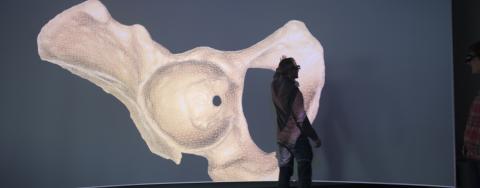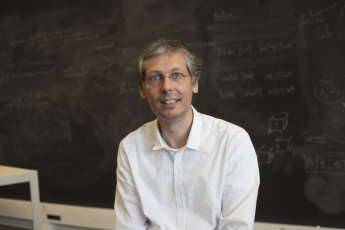
An Interdisciplinary Approach for Technological Advancement
Mathematician Pascal Frey heads the Institute for Computational and Data Sciences (ISCD).

Frey takes stock of ten years of interdisciplinary research and innovation around scientific computing, simulation and data analysis.
The Institute is celebrating its tenth anniversary this year. What were the initial challenges for the ISCD?
Pascal Frey: The Institute for Computing and Simulation was officially founded in June 2010. It was created because of the need to go beyond the disciplinary boundaries to take advantage of technological advances in machines and computers. The goal was to unite the strengths of specialists from different fields (computing, mathematics, chemistry, physics, biology, digital humanities, medicine, and others) to solve complex scientific and societal problems. Our ambition was also to pool our experience and resources to optimize the use of computing resources within the university.
This research federation was quickly structured in three main areas: research (development of methods and models), education (reinforced by our scientific advances), and software development. In 2016, with the rise of big data, we renamed it the "Institute of Computational and Data Sciences".
The ISCD works with project teams. How are they organized?
P. F.: The Labex* that we obtained in 2012 enabled us, initially, to organize into two themes: computational biology and chemistry. For eight years, 85 researchers and engineers and some 60 PhD candidates have been working on these issues.
To anticipate the end of the Labex and continue this momentum, we launched new research areas with our partners at the Sorbonne University Alliance and created two other teams: one on digital humanities and the other on personalized medicine.
This year, four new junior project-teams were created: one on the origins of language, another on materials and energy, a third on the analysis of data from marine stations and a fourth on the mathematical modeling of oceans.
Has this mode of operation worked?
P. F.: Our model has proved to be relevant, yes. In ten years, we have succeeded in attracting a large research community. From the outset, we worked with the faculties of Science & Engineering and Medicine, then with the Faculty of Arts & Humanities, and finally with most of the partners within the Sorbonne University Alliance. We also maintain close links with other institutes (such as the Institute of Materials, the Sea Institute, the Institute of Environmental Transition and the Collegium Musicae) and, more particularly, with the Sorbonne Center for Artificial Intelligence (SCAI), with whom we are developing a joint doctoral program and strengthening our synergies.
The mode of operation that we have developed over these ten years has enabled us to achieve major scientific advances in many fields. The first two SCAI teams, which wrapped up their projects within the institute in 2019, have now secured external funding, including the coveted ERC Synergy.
What impact does the research conducted within the ISCD have on society?
P. F.: Even if our research is mainly oriented towards fundamental issues, it also has direct consequences on society. We are working, for example, on genomics applied to kidney transplantation. With Prof. Ménard, a nephrologist at the Tenon hospital, we have developed a new method to improve donor and recipient compatibility by using genetic information in graft allocation criteria. Together with radiology professor Isabelle Thomassin, we are using data analysis to better detect breast cancer. We have also contributed our expertise in computational sciences to studies conducted at the Pierre Louis Institute of Epidemiology and Public Health on the current pandemic.
In a completely different field, called digital humanities, we have developed methods for analyzing text corpora. These techniques have many applications, both to improve the standardization of medical reports and to detect plagiarism. We are also working on digital archaeology and our teams have, for example, virtually reconstructed the Theater of Orange in France.
Interdisciplinarity is at the heart of Sorbonne University’s institutes. How do you encourage it within the ISCD?
P. F.: First of all, one must overcome a preconceived idea: working in an interdisciplinary way, for a scientist, does not mean mastering several fields at the same time. Only a few people really have this dual competence. It is therefore essential to form research tandems by associating the best specialists, doctoral candidates and post-doctoral researchers from different disciplines around the same subject.
In order to foster exchanges within our community, we organize working groups, summer schools and regular seminars during which teams present their methods and advances. Thanks to the Idex, the institutes benefit from a multi-year budget allowing research to be carried out over a long period of time. This time is necessary to develop a common language between these experts from different backgrounds.
An interdisciplinary approach is not as natural as we think. It also raises the problem of publications. For a scientist, developing research at the interface of several disciplines means accepting the risk that the work will not be understood by one’s peers. The Institute is also there to participate in and diminish this risk.
